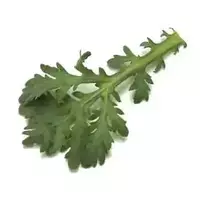Chrysanthemum leaves

Since ancient times, chrysanthemum has been known as a beautiful ornamental plant, but few people know that there is a unique edible from a variety of different species and varieties. Thus, chrysanthemum suitable for food is used for culinary purposes, using shoots, young leaves and flowers.
Regular use of chrysanthemum leaves as food has been shown to contribute to longer lifespans. In addition, this plant is widely used in medical and dietary nutrition. Chrysanthemum leaves are especially useful when fresh. They have a somewhat specific smell, but also a rather delicate aroma and savory taste.
As a rule, dark green carved chrysanthemum leaves (especially young ones) are usually added to salads, braised with vegetables, boiled. By the way, boiled or raw buds, as well as blossomed flowers, are often decorated with various dishes. And the first dishes are also prepared from chrysanthemum leaves and even salted for future use. Young shoots and chrysanthemum leaves are very similar in their taste to celery greens.
Both flowers and chrysanthemum leaves in Japan, as well as other East Asian countries, are especially popular. However, in recent years, demand for this plant has appeared in America and Europe. They discovered an annual vegetable chrysanthemum in Russia, where it is grown both outdoors and protected.
Chrysanthemum crowned or Chrysanthemum coronarium L. is considered a very beautiful annual herbaceous plant that belongs to the Astrovy family. It is distinguished by a rather powerful fleshy stem, the height of which can reach up to one meter. The leaves of the vegetable chrysanthemum resemble the leaves of carrots - they are the same openwork, carved and characterized by a light green color. It is noteworthy that after the next cutting, the chrysanthemum leaves can quickly grow back, for which it is often called an endless plant.
At least 3 thousand years have been engaged in the cultivation of chrysanthemum in China, and these flowers are bred not only for the purpose of aesthetic pleasure or for use in cooking, but also for use in medical practice. This is due to the fact that the chrysanthemum leaves contain a large amount of extremely useful substances for the body. In particular, the fresh greens of this plant contain vitamins of group B, C, PP, A. In addition, there are mineral salts in them, including calcium, magnesium, phosphorus and some others.
chrysanthemum leaves 24 kCal
The energy value of chrysanthemum leaves (Ratio of proteins, fats, carbohydrates - ju):
Proteins: 3.36 g (~ 13 kCal)
Fats: 0.56 g. (~ 5 kCal)
Carbohydrates: 0.01 g (~ 0 kCal)
Energy ratio (b | y): 56% | 21% | 0%
 Español
Español Français
Français Português
Português Русский
Русский 简体中文
简体中文 繁體中文
繁體中文 日本語
日本語 한국어
한국어 العربية
العربية Türkçe
Türkçe Қазақ
Қазақ Deutsch
Deutsch Italiano
Italiano Українська
Українська
